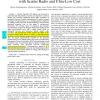Free Online Productivity Tools
i2Speak
i2Symbol
i2OCR
iTex2Img
iWeb2Print
iWeb2Shot
i2Type
iPdf2Split
iPdf2Merge
i2Bopomofo
i2Arabic
i2Style
i2Image
i2PDF
iLatex2Rtf
Sci2ools
TIM
2016
2016
Converting a Plant to a Battery and Wireless Sensor with Scatter Radio and Ultra-Low Cost
— Electric Potential (EP) signals are produced in plants through intracellular processes, in response to external stimuli (e.g. watering, mechanical stress, light, acquisition of nutrients). However, wireless transmission of a massive amount of biologic EP signals (from one or multiple plants) is hindered by existing, battery-operated wireless technology and increased, associated monetary cost. In this paper, a self-powered, battery-less EP wireless sensor is presented that harvests near-maximum energy from the plant itself and transmits the EP signal tens-of-meters away with a single switch, based on inherently low-cost and low-power bistatic scatter radio principles. The experimental results confirm the ability of the proposed wireless plant sensor to achieve a fully-autonomous operation by harvesting the energy generated by the plant itself. Also, EP signals experimentally acquired by the proposed wireless sensor from multiple plants, have been processed using Non-negative Matrix ...
| Added | 11 Apr 2016 |
| Updated | 11 Apr 2016 |
| Type | Journal |
| Year | 2016 |
| Where | TIM |
| Authors | Christos Konstantopoulos, Eftichios Koutroulis, Nikolaos Mitianoudis, Aggelos Bletsas |
Comments (0)

